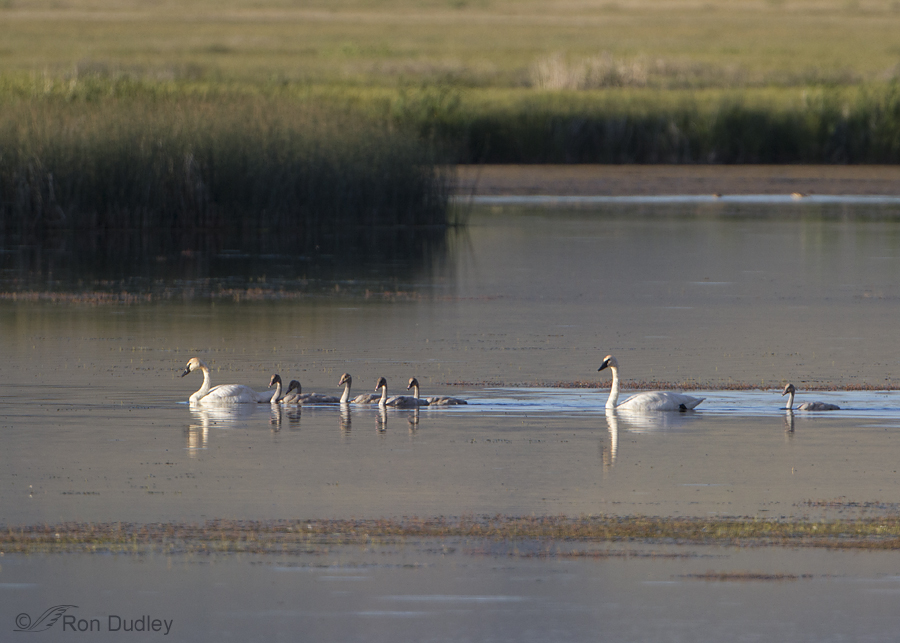Trumpeter Swans are the largest of all North American waterfowl, weighing up to 30 pounds and having a wingspan of as much as 8 feet. It’s hard to imagine that by the 1930’s this species had been almost wiped out. In 1949 the Director of the U.S. Fish and Wildlife Service said that the Trumpeter Swan was “the fourth rarest bird now remaining in America”. But thankfully recent intense swan restoration and management programs have brought the species back from the brink of extinction.
In recent years more than 500 pairs have been breeding in the Greater Yellowstone Ecosystem. Earlier this week I was privileged to see and photograph one of them in Montana’s Centennial Valley.
1/1000, f/6.3, ISO 500, 500 f/4, 1.4 tc
I was inside my camping trailer at 8:13 pm when I looked out the window and saw this swan family swimming by on the lake next to our camp site I slowly opened the trailer door, propped my heavy lens against the door frame and got a few sharp images as they passed to my left .
1/1000, f/6.3, ISO 500, 500 f/4, 1.4 tc
I’d known the adults and some cygnets were in the area because I had seen them before but these are very shy birds and usually stay far off on the very large lake so I had no idea there were this many cygnets. Average clutch size for the species is 5 so to see 6 youngsters raised to this size is encouraging indeed.
The drastic historic decline of Trumpeter Swans beginning during the early fur trade and settlement of North America by Europeans can be attributed to the demand for their skins, primary feathers and even their flesh. Following is a quote from Ed Forbes, a Kalispell, Montana rancher, that illustrates the prevailing attitude of the time: (from birdzilla.com, typos corrected)
“I punched cows in the Centennial Valley in Beaverhead County from 1883 to 1888. During that time I saw quantities of swans, and killed many young birds which we thought good to eat. We used to paddle after them among the tulies (bulrushes) and rope them, as they never seemed to learn to fly until ice formed around the shores, and were fearless, big, and awkward. Even then it took them a long, flapping flight to clear the water. The young birds would dive, and come up at a distance of 600 feet when chased with a boat.”
But 45 years earlier (1840) John James Audubon described the Trumpeter Swan in such a way as to show that at least some folks in the day had great appreciation for these splendid birds
“For a perfect conception of their beauty and elegance, you must observe them when they are not aware of your proximity, as they glide over the waters of some secluded inland pond. The neck, which at other times is held stiffly upright, moves in graceful curves, now bent forward, now inclined backwards over the body. The head, with an extended scooping movement, dips beneath the water, then with a sudden effort it throws a flood over its back and wings, while the sparkling globules roll off like so many large pearls. The bird then shakes its wings, beats the water, and, as if giddy with delight, shoots away, gliding over and beneath the surface of the stream with surprising agility and grace. Imagine a flock of fifty Swans thus sporting before you. I have more than once seen them. And you will feel, as I have felt, happier and freer of care than I can describe.” — J. J. Audubon
Thankfully, Audubon’s sentiment prevails today.
Ron




Talk about a scenic view from your camper! Wow!
Outstanding images of the healthy Swan family, Ron! I really liked the Audubon passage. He had a poetic sense when describing his favorite subjects.
Thanks, Wally. I like that Audubon quote also.
Thank you for the beautiful photos. This reminds me of reading “The Trumpet of the Swan” to my daughter when she was small. It was, and still is one of her favorite books.
Sounds like an interesting book, Tana and I’m glad it made such an impression on your daughter. Thank you.
Beautiful shots of an elusive family. I, too am glad Audubon’s expressed sentiments still survive today…and I’m glad Audubon himself does not. When studying a particular bird he’d kill hundreds of them. As a painter and lover of wildlife, I never like his methods…or his art. I guess this makes me an outcast. So be it.
Patty, I agree that Audubon’s methods seem inappropriate in this day and age (an understatement) but he was a product of his times and we’ve all benefited from his efforts, as have birds in the long run.
They are indeed beautiful birds. Glad to hear the good news of a larger clutch. I always like to know that previously endangered birds are coming back well.
Susan, I’ve seen Trumpeters in the area for 4 summers now and this is the largest group of youngsters I’ve noticed. Good news.